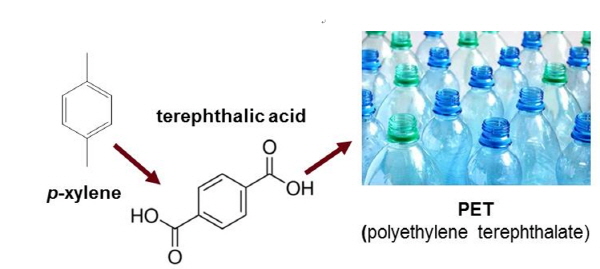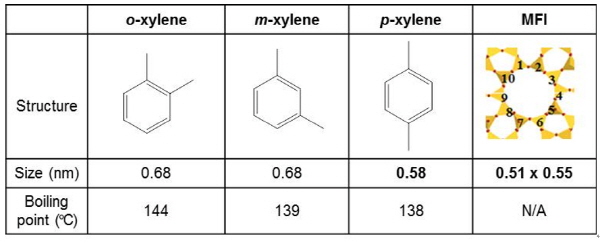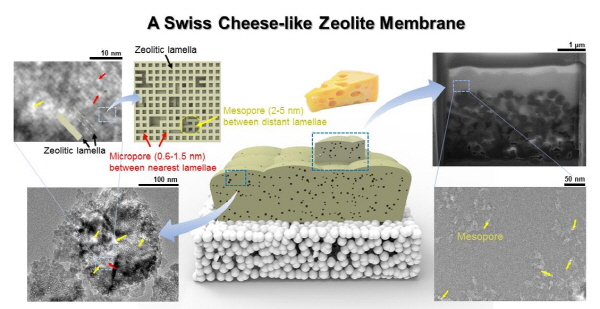Professor Choi Jung-kyu’s Group Develops
the World’s First Swiss Cheese-like Zeolite Membrane.
Hierarchical Structure with Mesopores
Published in the online edition of the Angewandte Chemie International Edition,
an international chemistry journal.

▲ (From left) Jeong Yang-hwan (integrated Master/Ph.D course), Doctor Hong Sung-won and Professor Choi Jung-kyu.
Doctor Hong Sung-won and Jeong Yang-hwan, a student in the integrated Master/Ph.D course, from Professor Choi Jung-kyu’s group in the Department of Chemical and Biological Engineering, College of Engineering, developed a zeolite membrane having a Swiss cheese-like hierarchical structure by introducing mesopores.
The zeolite membrane developed in their study has an excellent capability of separating xylene isomers that are normally quite difficult to separate due to their thermodynamic properties.
The oil refining and petrochemical industries are essential to daily lives because they provide key energy sources and basic compounds as well as many currently necessary chemical products (e.g., plastics, fertilizers, pharmaceuticals, packaging materials and fibers). It is true that such energy sources should be phased out as we transition to greener energies if we are to stop global heating and reverse its effects. According to some, the existing fossil fuels may not be immediately replaced due to reasons such as economic feasibility, and further research and development is needed. In addition, renewable energy sources are unable to replace the numerous petrochemical products that are used in our daily lives. Hence, efforts should be taken to increase energy efficiency by optimizing the existing industrial facilities and their processing operations. Therefore, the oil refining and petrochemical industries are essential industries in Korea that are expected to grow continuously, even in the future.
In particular, p-xylene, an important material in the petrochemical industry, is used as a critical raw material for the synthesis of terephthalic acid and dimethyl terephthalate, which are chemical intermediaries necessary in producing polyethylene terephthalate (PET; plastic bottles) and polyester (PES; clothing) (Figure 1). However, p-xylene exists as a mixture with its isomer, o-xylene/m-xylene. Hence, obtaining high purity p-xylene, which is highly demanded in industry, requires a process for separating the isomers.

▲ Figure 1. Process in producing the critical raw material for plastic bottles, PET from p-Xylene.
The separation of xylene isomers is generally performed by the PAREX method, in which the mixture is separated by using a simulated moving bed (SMB), and the isomerization process is achieved by distillation or crystallization. However, these processes include complicated procedures and consume much energy. The separation process employing a zeolite membrane having excellent thermal and chemical stability may be operated in a more energy-efficient manner in comparison with the traditional separation processes. Based on this advantage, the separation process may also be conducted more flexibly, saving the huge space required by the conventional processes.
Zeolite Socony Mobil-five (MFI) crystals have micropores that are suitable for the separation of xylene isomers, and a continuous membrane made of the crystals thus has great potential for effectively separating and purifying p-xylene. Therefore, a continuous membrane consisting of MFI crystals may play the role of a molecular-sieve that can selectively separate p-xylene from a mixture of xylene isomers according to molecular size (Table 1).
▼ Table 1. The molecular structures and properties of xylene isomers and the pore structure and size of the MFI zeolite crystals.

However, since the pore size of the MFI zeolite is similar to the size of the p-xylene that permeates the membrane, the membrane has a low permeance. Using a membrane having a low permeance decreases the treatment capacity and lowers its economic feasibility because a large process is required. This drawback limits the application of a zeolite membrane in real-world processes despite its high separation capability. Recognizing the problem, Professor Choi Jung-kyu’s group proposed the world’s first method for preparing a zeolite membrane of a hierarchical structure by introducing mesopores (a next-generation zeolite membrane having a micropore/mesopore hybrid structure) (Figure 2). This unique membrane structure gives a high permeance. In particular, from a pragmatic engineering perspective, an easy and highly reproducible method was employed to prepare the membrane.

▲
Figure 2. Schematics of a common MFI zeolite membrane and a MFI zeolite membrane having a micropore/mesopore hybrid structure.
Specifically, when micropores and mesopores are present together in a zeolite membrane, the molecules passing through the membrane may move quickly through the mesopores, and the membrane permeance is thus improved. Therefore, while the mechanical strength is maintained by the same membrane thickness, the substantial distance through which the gas molecules penetrate is reduced to effectively enhance the penetration rate. In addition, the MFI membrane having a micropore/mesopore hybrid structure has a high p-xylene permeance, as well as a high process stability at high temperatures. High temperature separation processes generally decrease the penetration performance because of the coke (coal residue) formed in the membrane. However, the MFI membrane of the hybrid structure, including larger mesopores, may keep the entire membrane performance high for a long time, even if the undesired coke is formed.
Therefore, the hybrid Swiss cheese-like MFI zeolite membrane of a hierarchical structure with micropores and mesopores has a high permeance, as well as excellent separation performance. In addition, the separation performance is maintained and the permeance is little decreased, even in a long high temperature separation process thanks to the mesopores, and the membrane can be appropriately applied to a real-world membrane process (Figure 3).

▲ Figure 3. Schematic of the hybrid MFI zeolite membrane, including micropores and mesopores, and the introduced mesopores and TEM images of the hybrid MFI zeolite cross-section and the actual mesopores.
Professor Choi Jung-kyu of Korea University said, “Doctor Hong Sung-won and Jeong Yang-hwan, one of my students, were able to synthesize the world’s first zeolite membrane having a unique micropore/mesopore hybrid structure through their creative research. That was possible because they were aiming at the development of technologies that are required by and applicable to the actual oil refining and petrochemical industries.” He also explained the significance of the study: “Our zeolite membrane technology may be applied to the petrochemical industry to achieve the process in a more energy-efficient manner.”
The present study was supported by the Mid-Career Researcher Program of the National Research Foundation of Korea, the Korea Carbon Capture and Storage R&D Center (KCRC, President Park, Sang-do) and the Engineering Research Center Program (Super Ultra Low Energy and Emission Vehicle Center led by Lee, Gwan-yeong). The article was published in the online edition of the Angewandte Chemie International Edition, which is an internationally renowned chemistry journal, on October 7.
*Title of article: An Extrinsic Pore-Containing Molecular Sieve Film: A Robust, High-Throughput Membrane Filter
[Terms Explained]
▣ Zeolite
Zeolite is an inorganic crystal material formed by substituting some silicon atoms of silicon oxide with aluminum atoms and has pores smaller than 1 nm. More than 200 independent structures of zeolite possessing unique crystal structures have been reported, and they are represented by three-character codes (e.g., MFI (Zeolite Socony Mobil-five), CHA (Chabazite), DDR (Deca-dodecasil 3 Rhombohedral) and LTA (Linde Type A)). Zeolite is extensively used in various fields in ion exchangers, catalysts, catalyst matrices, adsorbents and membranes.



